-
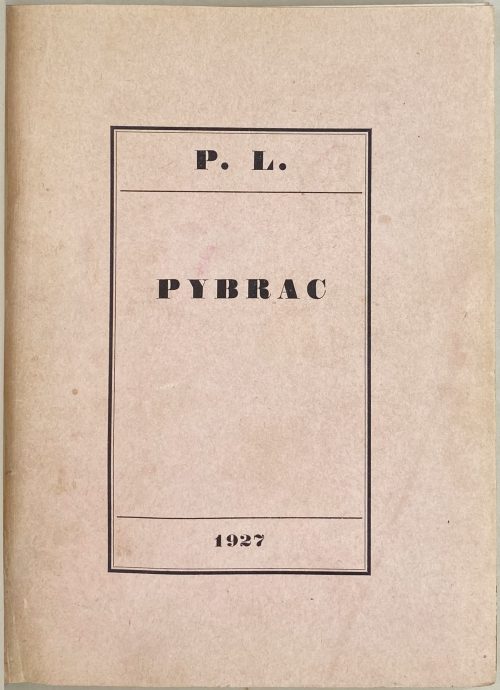 Description: Hardcover, 19.3 x 15 cm, printed on thick wove paper watermarked “J. PERRIGOT MBM ARCHES (France)”, bound by Thomas Boichot (signed 'BOICHOT' on front pastedown) in silver buckram with a white floral diaper, original front wrapper preserved, top margin gilt; engraved bookplate of Roger Peyrefitte by Pierre-Yves Trémois, 1972, to front pastedown lettered “SEX | LIBRIS | ROGER | PEYREFITTE | {vignette} | Trémois | 72”; bookplate of J.-P. Dutel to binder’s flyleaf. Description by the seller: Plein papier à la Bradel, tête dorée, non rogné, premier plat de couverture conservé. (Boichot). Édition originale publiée en 1927 par René Bonnel ornée dans le titre d’une vignette gravée par Foujita. Tirage : 5 ex. sur Japon ancien. 100 ex. sur vélin d’Arches. EXEMPLAIRE UNIQUE. UN DES 100 SUR VÉLIN D’ARCHES (N°97), ENRICHI DE 8 AQUARELLES LIBRES. Provenance: Roger Peyrefitte (Ex-libris érotique gravé par Trémois). Collation: Pink front wrapper, lettered in frame “P. L. |—| PYBRAC |—| 1927”, 2 blank leaves, [1] h.t., [1] t.p. in red and black with engraved vignette by Foujita, [2] (Sur la chemise…), [2] f.t. / blank, [5] 6-98 [2 colophon/blank], 2 blank leaves, total 52 leaves plus four blanks and a wrapper. Title-page (red and black): PIERRE LOUŸS | PYBRAC | POESIES | {vignette} | CYTHÈRE | AU COQ HARDI || Edition: Limited edition of 105 copies of which this is copy № 97 on Arches paper, enhanced with eight in-text colour drawings by an anonymous artist (unique copy). Another unique copy of the same edition illustrated by an anonymous artist in this collection LIB-3130.2023. Contributors: Pierre Louÿs (French, 1870 – 1925) – author. Léonard Tsuguharu Foujita (Japanese-French, 1886 – 1968) – artist (t.p. vignette). Roger Peyrefitte (French, 1907 – 2000) – provenance. Pierre-Yves Trémois (French, 1921 – 2020) – artist (bookplate) René Bonnel (French, 1884 – 1975) – publisher. Thomas Boichot – bookbinder.
Description: Hardcover, 19.3 x 15 cm, printed on thick wove paper watermarked “J. PERRIGOT MBM ARCHES (France)”, bound by Thomas Boichot (signed 'BOICHOT' on front pastedown) in silver buckram with a white floral diaper, original front wrapper preserved, top margin gilt; engraved bookplate of Roger Peyrefitte by Pierre-Yves Trémois, 1972, to front pastedown lettered “SEX | LIBRIS | ROGER | PEYREFITTE | {vignette} | Trémois | 72”; bookplate of J.-P. Dutel to binder’s flyleaf. Description by the seller: Plein papier à la Bradel, tête dorée, non rogné, premier plat de couverture conservé. (Boichot). Édition originale publiée en 1927 par René Bonnel ornée dans le titre d’une vignette gravée par Foujita. Tirage : 5 ex. sur Japon ancien. 100 ex. sur vélin d’Arches. EXEMPLAIRE UNIQUE. UN DES 100 SUR VÉLIN D’ARCHES (N°97), ENRICHI DE 8 AQUARELLES LIBRES. Provenance: Roger Peyrefitte (Ex-libris érotique gravé par Trémois). Collation: Pink front wrapper, lettered in frame “P. L. |—| PYBRAC |—| 1927”, 2 blank leaves, [1] h.t., [1] t.p. in red and black with engraved vignette by Foujita, [2] (Sur la chemise…), [2] f.t. / blank, [5] 6-98 [2 colophon/blank], 2 blank leaves, total 52 leaves plus four blanks and a wrapper. Title-page (red and black): PIERRE LOUŸS | PYBRAC | POESIES | {vignette} | CYTHÈRE | AU COQ HARDI || Edition: Limited edition of 105 copies of which this is copy № 97 on Arches paper, enhanced with eight in-text colour drawings by an anonymous artist (unique copy). Another unique copy of the same edition illustrated by an anonymous artist in this collection LIB-3130.2023. Contributors: Pierre Louÿs (French, 1870 – 1925) – author. Léonard Tsuguharu Foujita (Japanese-French, 1886 – 1968) – artist (t.p. vignette). Roger Peyrefitte (French, 1907 – 2000) – provenance. Pierre-Yves Trémois (French, 1921 – 2020) – artist (bookplate) René Bonnel (French, 1884 – 1975) – publisher. Thomas Boichot – bookbinder. -
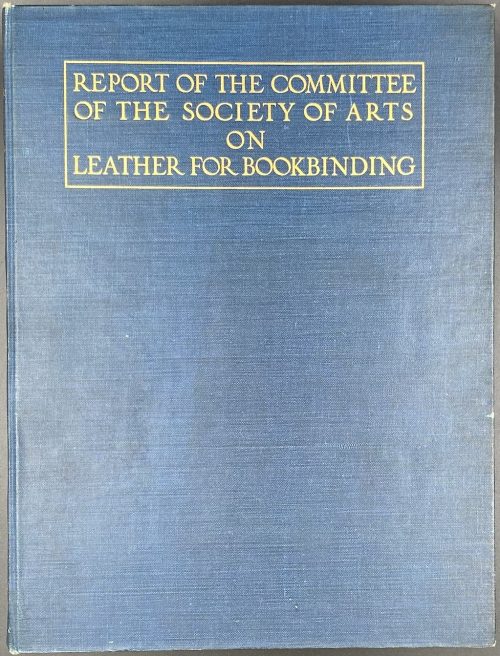 Description: hardcover, 25.2 x 19.2 cm, 8vo, dark blue cloth, gilt lettering in a frame to cover and gilt lettering to spine; captured leather samples pasted to front and back pastedowns, grey endpapers, colour frontispiece, 10 colour plates, multiple in-text b/w illustrations. Collation: a1 blank, a2 h.t./imprint, colour frontis. pasted in, a3 t.p./blank, a4 committee/blank; b2, (no A), B-H8, I5 (10 leaves H1 – I2 with colour plates pasted in, I5 colophon/blank); pagination starts at B2: [1] 2-120 [2]; total a4 b2 B-H8 I5 =67 leaves, 11 colour plates, incl. frontispiece. Title-page: REPORT OF THE COMMITTEE | ON | LEATHER FOR BOOKBINDING. | EDITED FOR | THE SOCIETY OF ARTS | AND | THE WORSHIPFUL COMPANY OF LEATHERSELLERS | BY | THE RT. HON. VISCOUNT COBHAM | CHAIRMAN OF THE COMMITTEE | AND | SIR HENRY TRUEMAN WOOD, M.A. | SECRETARY OF THE SOCIETY | LONDON : | PUBLISHED FOR THE SOCIETY OF ARTS | BY GEORGE BELL & SONS, | YORK HOUSE, PORTUGAL STREET, W.C. | — | 1905 || Contributors: Authors:
Description: hardcover, 25.2 x 19.2 cm, 8vo, dark blue cloth, gilt lettering in a frame to cover and gilt lettering to spine; captured leather samples pasted to front and back pastedowns, grey endpapers, colour frontispiece, 10 colour plates, multiple in-text b/w illustrations. Collation: a1 blank, a2 h.t./imprint, colour frontis. pasted in, a3 t.p./blank, a4 committee/blank; b2, (no A), B-H8, I5 (10 leaves H1 – I2 with colour plates pasted in, I5 colophon/blank); pagination starts at B2: [1] 2-120 [2]; total a4 b2 B-H8 I5 =67 leaves, 11 colour plates, incl. frontispiece. Title-page: REPORT OF THE COMMITTEE | ON | LEATHER FOR BOOKBINDING. | EDITED FOR | THE SOCIETY OF ARTS | AND | THE WORSHIPFUL COMPANY OF LEATHERSELLERS | BY | THE RT. HON. VISCOUNT COBHAM | CHAIRMAN OF THE COMMITTEE | AND | SIR HENRY TRUEMAN WOOD, M.A. | SECRETARY OF THE SOCIETY | LONDON : | PUBLISHED FOR THE SOCIETY OF ARTS | BY GEORGE BELL & SONS, | YORK HOUSE, PORTUGAL STREET, W.C. | — | 1905 || Contributors: Authors:Society of Arts (Great Britain)
Charles George Lyttleton Cobham (British, 1842 – 1922)
Henry Trueman Wood (British, 1879 – 1917), Secretary of the Royal Society of Arts (1879–1917).
George Bell & Sons – publisher. William Clowes and Sons – printer. -
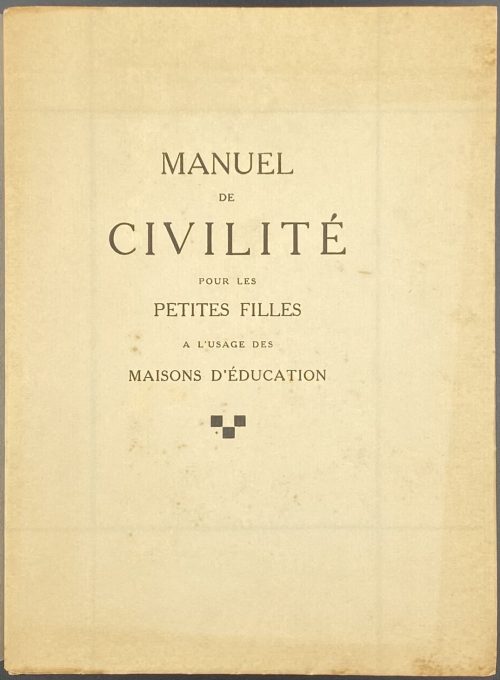 Softcover, collated 8vo, 19.5 x 14.2 cm, French flapped wrappers, lettering to front: MANUEL | DE | CIVILITÉ | POUR LES | PETITES FILLES | À L’USAGE DES | MAISONS D’ÉDUCATION | {checks} ||; printed on BFK Rives wove paper with watermark, with blue vertical and horizontal lines to imitate notebook checkered paper; pp.: [8] [1-15] 16-177 [7]; π4 1-118 124; total 96 leaves (192 pages), incl. those in wrappers. Cardboard double slipcase with vellum spine lettered in black: MANUEL | DE | CIVILITÉ | POUR | LES PETITES | FILLES ||. Title-page: similar to cover, within the frame: MANUEL | DE | CIVILITÉ | POUR LES | PETITES FILLES | À L’USAGE DES | MAISONS D’ÉDUCATION | {checks} || Edition: 1st clandestine limited edition of 600 copies of which 1 copy on papier de chine (№ 1), 15 copies on japon impérial (№№ 2-16), 20 copies on papier de Hollande (№№ 17-36), and 564 copies on vélin de Rives (№№ 37-600) ; this is copy № 473. Enrichment: Accompanied by 5 loose sheets of thin paper blind stamped in the upper-left corner “WHATMAN” with pencil and watercolour drawings, one on both sides, unsigned. Insert two printouts from the previous sellers. Catalogue raisonné: Pia 800/801; Dutel (III) 1916 (indicates 180 pp.). Nordmann II 315 describes copy № 246 illustrated with 86 compositions by Rojankovsky, all signed by Rojan. Later edition, see: LIB-2972.2022. Contributors: Pierre Louÿs (French, 1870 – 1925) Feodor Rojankovsky [Rojan, Фёдор Степанович Рожанковский] (Russian-American, 1891 – 1970).
Softcover, collated 8vo, 19.5 x 14.2 cm, French flapped wrappers, lettering to front: MANUEL | DE | CIVILITÉ | POUR LES | PETITES FILLES | À L’USAGE DES | MAISONS D’ÉDUCATION | {checks} ||; printed on BFK Rives wove paper with watermark, with blue vertical and horizontal lines to imitate notebook checkered paper; pp.: [8] [1-15] 16-177 [7]; π4 1-118 124; total 96 leaves (192 pages), incl. those in wrappers. Cardboard double slipcase with vellum spine lettered in black: MANUEL | DE | CIVILITÉ | POUR | LES PETITES | FILLES ||. Title-page: similar to cover, within the frame: MANUEL | DE | CIVILITÉ | POUR LES | PETITES FILLES | À L’USAGE DES | MAISONS D’ÉDUCATION | {checks} || Edition: 1st clandestine limited edition of 600 copies of which 1 copy on papier de chine (№ 1), 15 copies on japon impérial (№№ 2-16), 20 copies on papier de Hollande (№№ 17-36), and 564 copies on vélin de Rives (№№ 37-600) ; this is copy № 473. Enrichment: Accompanied by 5 loose sheets of thin paper blind stamped in the upper-left corner “WHATMAN” with pencil and watercolour drawings, one on both sides, unsigned. Insert two printouts from the previous sellers. Catalogue raisonné: Pia 800/801; Dutel (III) 1916 (indicates 180 pp.). Nordmann II 315 describes copy № 246 illustrated with 86 compositions by Rojankovsky, all signed by Rojan. Later edition, see: LIB-2972.2022. Contributors: Pierre Louÿs (French, 1870 – 1925) Feodor Rojankovsky [Rojan, Фёдор Степанович Рожанковский] (Russian-American, 1891 – 1970). -
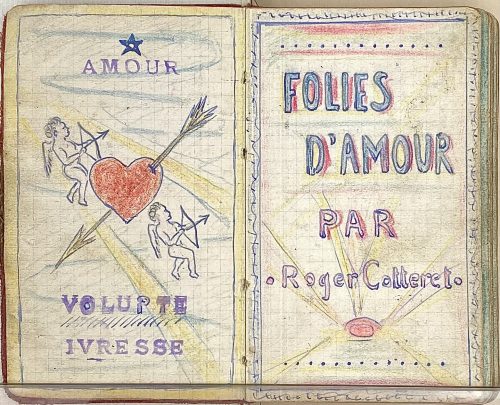 Lavishly illustrated manuscript bound in brown cloth with a red cloth border, 12.3 x 7.5 x 1.6 cm, green marbled endpapers with the inscription “Mein | Kampf” to free leaf, front pastedown with a pocket; written with blue ink and drawn with colour crayons on checkered notepaper with rounded corners, unpaginated, 104 leaves total. Frontispiece: ☆ | AMOUR | {two cupids and a heart pierced with an arrow, sunbeams} | VOLUPTE | IVRESSE || Title-page: FOLIES | D'AMOUR | PAR | • Roger Cotteret • | {raising sun and sunbeams} | row of dots || A copy of the whole manuscript is presented here.
Lavishly illustrated manuscript bound in brown cloth with a red cloth border, 12.3 x 7.5 x 1.6 cm, green marbled endpapers with the inscription “Mein | Kampf” to free leaf, front pastedown with a pocket; written with blue ink and drawn with colour crayons on checkered notepaper with rounded corners, unpaginated, 104 leaves total. Frontispiece: ☆ | AMOUR | {two cupids and a heart pierced with an arrow, sunbeams} | VOLUPTE | IVRESSE || Title-page: FOLIES | D'AMOUR | PAR | • Roger Cotteret • | {raising sun and sunbeams} | row of dots || A copy of the whole manuscript is presented here. -
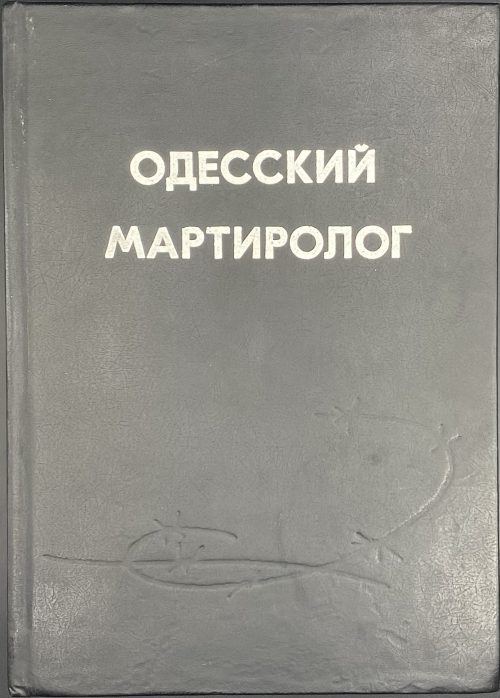 Hardcover volume, 24.2 x 17.2 cm, bound in black buckram with blind barbed wire design and silver lettering to front cover and spine, pp.: [2] 3-892 [4]. Одеський мартиролог: Данi про репресованих Одеси i Одеськоï областi за роки радянськоï влады (Серiя «Реабiлiтованi iсторiэю») (Том 3) / Уклад.: Л. В. Ковальчук, Г. О. Разумов— Одеса : ОКФА, 2005. Title-page: Научно-документальная серия книг | «РЕАБИЛИТИРОВАННЫЕ ИСТОРИЕЙ» | ОДЕССКИЙ | МАРТИРОЛОГ | ТОМ 3 | Одесса | ОКФА | 2005 || ISBN: 966-571-124-5 Print run: 1,000 copies. Ковальчук, Лидия Всеволодовна Разумов, Георгий Александрович
Hardcover volume, 24.2 x 17.2 cm, bound in black buckram with blind barbed wire design and silver lettering to front cover and spine, pp.: [2] 3-892 [4]. Одеський мартиролог: Данi про репресованих Одеси i Одеськоï областi за роки радянськоï влады (Серiя «Реабiлiтованi iсторiэю») (Том 3) / Уклад.: Л. В. Ковальчук, Г. О. Разумов— Одеса : ОКФА, 2005. Title-page: Научно-документальная серия книг | «РЕАБИЛИТИРОВАННЫЕ ИСТОРИЕЙ» | ОДЕССКИЙ | МАРТИРОЛОГ | ТОМ 3 | Одесса | ОКФА | 2005 || ISBN: 966-571-124-5 Print run: 1,000 copies. Ковальчук, Лидия Всеволодовна Разумов, Георгий Александрович -
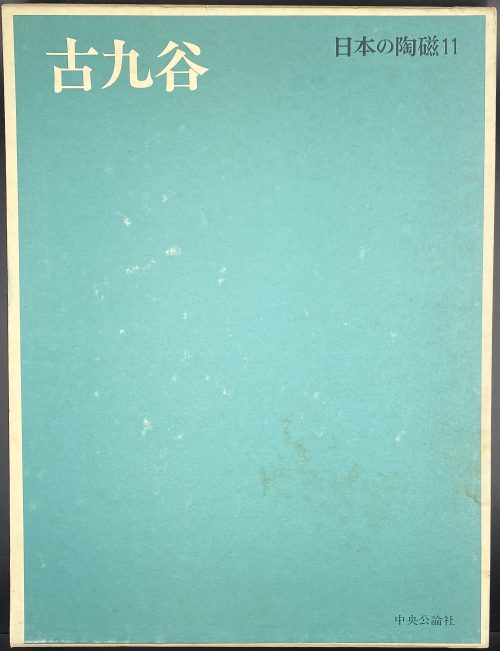 Hardcover volume, 35 x 26.8 cm, bound in grey cloth, blind stamped characters to front, brown characters to spine, in a slipcase, the outer case missing, pp.: [4] [1] 2-136 (plates with photographs of 211 items), [2] 139-166 [4]. Kutani ware [九谷焼] (Kutani-yaki); old kutani [古九谷] (kokutani) – ceramic objects produced in Kutani in the 17th century. 日本の陶磁 – Japanese ceramics, series title. Contributors: Yasunari Kawabata [川端 康成] (Japanese, 1924 – 1972) – author. Tetsuzo Tanikawa [谷川 徹三] (Japanese, 1895 – 1989) – author. Seizo Hayashiya [林屋晴三] (Japanese, 1928 – 2017) – editor. Chūōkōron-sha [中央公論社] – publisher.
Hardcover volume, 35 x 26.8 cm, bound in grey cloth, blind stamped characters to front, brown characters to spine, in a slipcase, the outer case missing, pp.: [4] [1] 2-136 (plates with photographs of 211 items), [2] 139-166 [4]. Kutani ware [九谷焼] (Kutani-yaki); old kutani [古九谷] (kokutani) – ceramic objects produced in Kutani in the 17th century. 日本の陶磁 – Japanese ceramics, series title. Contributors: Yasunari Kawabata [川端 康成] (Japanese, 1924 – 1972) – author. Tetsuzo Tanikawa [谷川 徹三] (Japanese, 1895 – 1989) – author. Seizo Hayashiya [林屋晴三] (Japanese, 1928 – 2017) – editor. Chūōkōron-sha [中央公論社] – publisher. -
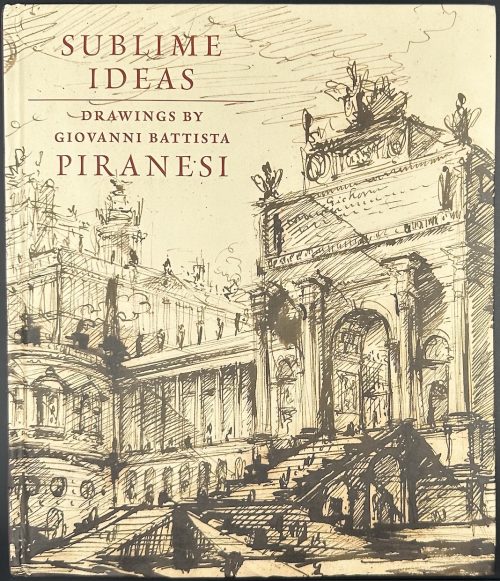 Hardcover volume, 28.7 x 24.7 cm, pictorial paper boards, pictorial endpapers, pp. :[1-6] 7-224, 207 colour ils. Published on the occasion of an exhibition at the Morgan Library & Museum, 10 March to 4 June 2023. Title-page: SUBLIME IDEAS | — | DRAWINGS BY | GIOVANNI BATTISTA | PIRANESI | John Marciari | THE MORGAN LIBRARY & MUSEUM, NEW YORK | in association with | PAUL HOLBERTON PUBLISHING || Contributors: John Marciari (American, b. 1971) – author. Giovanni Battista [Giambattista] Piranesi (Italian, 1720 – 1778) – artist.
Hardcover volume, 28.7 x 24.7 cm, pictorial paper boards, pictorial endpapers, pp. :[1-6] 7-224, 207 colour ils. Published on the occasion of an exhibition at the Morgan Library & Museum, 10 March to 4 June 2023. Title-page: SUBLIME IDEAS | — | DRAWINGS BY | GIOVANNI BATTISTA | PIRANESI | John Marciari | THE MORGAN LIBRARY & MUSEUM, NEW YORK | in association with | PAUL HOLBERTON PUBLISHING || Contributors: John Marciari (American, b. 1971) – author. Giovanni Battista [Giambattista] Piranesi (Italian, 1720 – 1778) – artist. -
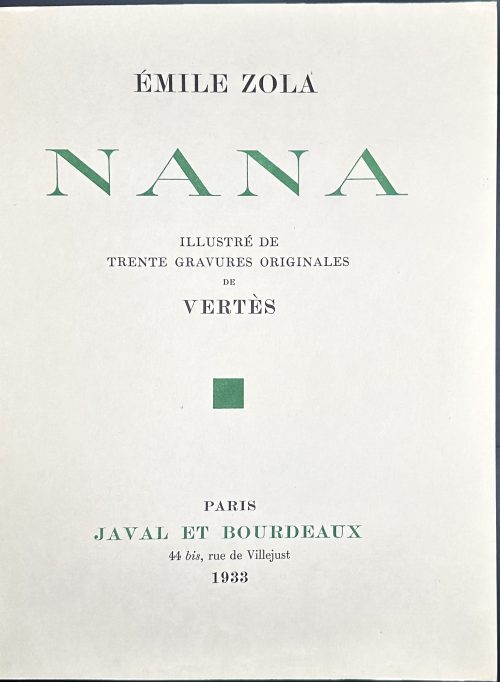 Publisher’s olive French flapped wrappers, in-4to, 33 x 25.3 x 6 cm, green and black lettering to front and spine, in a glassine dust jacket, in a marbled double slipcase 34.5 x 25.5 cm, unbound; pp.: [8] 1-436 [4], plus 30 colour plates with guard tissue, extraneous to collation; edition enriched with a set of 30 uncoloured etchings with guard tissue in a lettered paper folder. Title-page: ÉMILE ZOLA | NANA | ILLUSTRÉ DE | TRENTE GRAVURES ORIGINALES | DE | VERTÈS |◾| PARIS | JAVAL ET BOURDEAUX | 44 bis, rue de Villejust | 1933 || Justification du tirage: il a été tiré de «Nana » d'Émile Zola. Soixante exemplaires sur japon impérial, numérotés de 1 a 60, avec un état en couleurs colorié a la main et un état en noir des trente gravures originales de Vertès. [Edition limited to 60 copies, this is copy № 54]. Colophon: « NANA », D'ÉMILE ZOLA, ÉTÉ ACHEVÉ D'IMPRIMER LE TRENTE AVRIL MIL NEUF CENT TRENTE-TROIS, EN CARACTÈRES ROMAIN ANGLAIS DU CORPS 16, SUR LES PRESSES DU MAITRE IMPRIMEUR COULOUMA, À ARGENTEUIL, H. BARTHÉLEMY, DIRECTEUR. LES COMPOSITIONS DE VERTÈS ONT ÉTÉ REPRODUITES EN FAC-SIMILÉ PAR D. JACOMET & Cie. Printed on April 30, 1933 by Coulouma in Argenteuil, H. Barthélemy, director; illustrations reproduced in facsimile by D. Jacomet & Co. Catalogue raisonné: Vokaer 30. Contributors: Émile Zola (French, 1840 – 1902) – author. Marcel Vertès [Marcell Vértes] (Jewish-Hungarian-French, 1895 – 1961) – artist. Javal et Bourdeaux – publisher. Daniel Jacomet (French, 1894 – 1966) – printer. Seller's description: Nana. Paris, Javal et Bourdeaux, 1933. 2 volumes in-4, en feuilles, non coupé, non rogné, chemise et étui. Ouvrage illustré de 30 gravures originales en couleurs de Marcel Vertès. Tirage à 60 exemplaires sur japon impérial contenant un état des illustrations coloriées à la main en couleurs et un état en noir. Chemise et emboîtage insolés.
Publisher’s olive French flapped wrappers, in-4to, 33 x 25.3 x 6 cm, green and black lettering to front and spine, in a glassine dust jacket, in a marbled double slipcase 34.5 x 25.5 cm, unbound; pp.: [8] 1-436 [4], plus 30 colour plates with guard tissue, extraneous to collation; edition enriched with a set of 30 uncoloured etchings with guard tissue in a lettered paper folder. Title-page: ÉMILE ZOLA | NANA | ILLUSTRÉ DE | TRENTE GRAVURES ORIGINALES | DE | VERTÈS |◾| PARIS | JAVAL ET BOURDEAUX | 44 bis, rue de Villejust | 1933 || Justification du tirage: il a été tiré de «Nana » d'Émile Zola. Soixante exemplaires sur japon impérial, numérotés de 1 a 60, avec un état en couleurs colorié a la main et un état en noir des trente gravures originales de Vertès. [Edition limited to 60 copies, this is copy № 54]. Colophon: « NANA », D'ÉMILE ZOLA, ÉTÉ ACHEVÉ D'IMPRIMER LE TRENTE AVRIL MIL NEUF CENT TRENTE-TROIS, EN CARACTÈRES ROMAIN ANGLAIS DU CORPS 16, SUR LES PRESSES DU MAITRE IMPRIMEUR COULOUMA, À ARGENTEUIL, H. BARTHÉLEMY, DIRECTEUR. LES COMPOSITIONS DE VERTÈS ONT ÉTÉ REPRODUITES EN FAC-SIMILÉ PAR D. JACOMET & Cie. Printed on April 30, 1933 by Coulouma in Argenteuil, H. Barthélemy, director; illustrations reproduced in facsimile by D. Jacomet & Co. Catalogue raisonné: Vokaer 30. Contributors: Émile Zola (French, 1840 – 1902) – author. Marcel Vertès [Marcell Vértes] (Jewish-Hungarian-French, 1895 – 1961) – artist. Javal et Bourdeaux – publisher. Daniel Jacomet (French, 1894 – 1966) – printer. Seller's description: Nana. Paris, Javal et Bourdeaux, 1933. 2 volumes in-4, en feuilles, non coupé, non rogné, chemise et étui. Ouvrage illustré de 30 gravures originales en couleurs de Marcel Vertès. Tirage à 60 exemplaires sur japon impérial contenant un état des illustrations coloriées à la main en couleurs et un état en noir. Chemise et emboîtage insolés. -
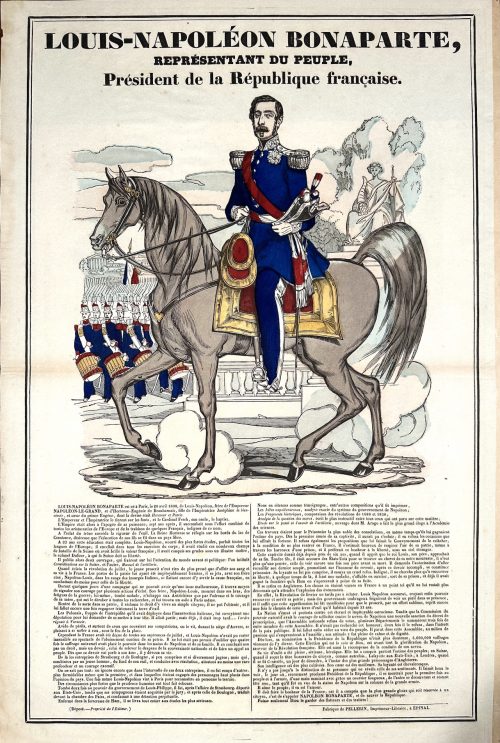 Hand-coloured woodcut poster on wove paper, 622 x 417 mm; black ink stamp “4859” to reverse, horizontal centrefold. In a double frame, top: LOUIS-NAPOLÉON BONAPARTE, | REPRÉSENTANT DU PEUPLE, | Président de la République française. Text under the image ; bottom left: (Déposé.— Propriété de l’Éditeur.); right: Fabrique de PELLERIN, Imprimeur-Libraire, à ÉPINAL. Jean Charles Pellerin (French, 1756 – 1836) – printer/publisher.
Hand-coloured woodcut poster on wove paper, 622 x 417 mm; black ink stamp “4859” to reverse, horizontal centrefold. In a double frame, top: LOUIS-NAPOLÉON BONAPARTE, | REPRÉSENTANT DU PEUPLE, | Président de la République française. Text under the image ; bottom left: (Déposé.— Propriété de l’Éditeur.); right: Fabrique de PELLERIN, Imprimeur-Libraire, à ÉPINAL. Jean Charles Pellerin (French, 1756 – 1836) – printer/publisher. -
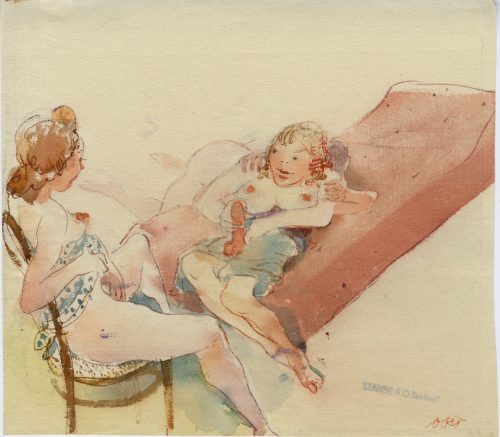 Watercolour on laid paper, 198 x 225 mm, signed or stamped in orange ink “ORS” to recto [Otto Rudolf Schatz (Austrian, 1900 – 1961)]; black ink stamp: “Nachlaß O R SCHATS”, pencil “ss” in the bottom left corner, and remnants of a hinge on the upper right to verso.
Watercolour on laid paper, 198 x 225 mm, signed or stamped in orange ink “ORS” to recto [Otto Rudolf Schatz (Austrian, 1900 – 1961)]; black ink stamp: “Nachlaß O R SCHATS”, pencil “ss” in the bottom left corner, and remnants of a hinge on the upper right to verso. -
 Iron tsuba of round form profusely decorated with brass inlay of plants, birds, well, and family crests (mon) in suemon-zōgan technique and occasional brass dots (nail-heads) or ten-zōgan. Seppa-dai and kozuka-hitsu-ana outlined with brass inaly, possibly repaired: rope-shaped wire here and there replaced with flat wire. The plate is very thin, with remnants of lacquer. Ōnin school. Size: 75.8 x 75.2 x 2.3 mm. Weight: 77.5 g. On the front side (omote) motif includes the following elements (from 12 o'clock, clockwise):
Iron tsuba of round form profusely decorated with brass inlay of plants, birds, well, and family crests (mon) in suemon-zōgan technique and occasional brass dots (nail-heads) or ten-zōgan. Seppa-dai and kozuka-hitsu-ana outlined with brass inaly, possibly repaired: rope-shaped wire here and there replaced with flat wire. The plate is very thin, with remnants of lacquer. Ōnin school. Size: 75.8 x 75.2 x 2.3 mm. Weight: 77.5 g. On the front side (omote) motif includes the following elements (from 12 o'clock, clockwise):- Water plantain (a.k.a. arrowhead, or omodaka): "a perpetual plant of the water plantain family, was also called shōgunsō (victorious army grass). Because of this martial connotation, it was a design favored for the crests of samurai families" [see: Family Crests of Japan. // Stone Bridge Press, Berkeley, CA, 2007; p. 63].
- Heron (sagi): "...considered an emblem of longevity, and from China comes the practice of regarding the bird as a mount of the gods and the Taoist sennin. [...] heron also reflects an inauspicious connotation, for the word sagi is homophone for 'fraud' and 'false pretenses'." [see: Merrily Baird. Symbols of Japan. Thematic motifs in art and design. // Rizzoli international publications, Inc., 2001; p. 112]. Some may say, that this is not a heron but a crane (tsuru). It's very possible, and in this case the negative connotation is lost, but the reference to longevity and allusion to sennin remain.
- Pampas grass (susuki, or obana): as per Merrily Baird, p. 95 and John W. Dower, p. 66, pampas grass is one of the Seven Grasses of Autumn. When combined with flying wild gees, conveys strong autumnal mood.
- Plum blossom (ume): according to Merrily Baird, the flower has a vast variety of symbolic meanings, including longevity, and a reference to the Chinese Taoists. It is used in 80 family crests [see: Japanese Design Motifs: 4,260 Illustrations of Japanese Crests; Compiled by the Matsuya Piece-Goods Store; Translated by Fumie Adachi. // Dover Publications, Inc., 1972.] Plum is "celebrated for its sweet perfume, delicate blossoms, and habit of blooming at the end of winter".
- Tree flying wild geese (kari): "Wild geese arrive in large flocks in southern regions during the autumn months, and following their migratory instincts, head back north in spring" [Family Crests of Japan, pp. 85-86]. "The importance of geese in Japanese art was further secured by stories of several military heroes who had achieved victory in battle when a sudden breaking of ranks by flying geese signaled an ambush. The protective role of the birds led to their frequent use in decorating sword furnishings and possibly also their adoption as a family crest motif.Finally, the goose in Asia plays a role in religious traditions" [Merrily Baird, pp.111-112].
- Hikiryō (line, or bar, or stripe) - a symbol which consists of one, two, or three horizontal or vertical stripes in a circle. "In wartime, Japanese generals [...] surrounded their encampments with huge cloth curtains. Usually these were made of cloth sewn together horizontally and varying in color [...] to distinguish the individual general and his followers. The stripe thus assumed strong martial connotations, and became a mark of identification on personal military gear as well. In the early fourteenth century the heads of the Ashikaga and Nitta, then the two most powerful clans in Japan, both adopted stripe patterns as a family crest". [See: Family Crests of Japan, p. 111 and John W. Dower. The elements of Japanese design - A handbook of family crests, heraldry & symbolism. // Weatherhill, New York, Tokyo, 1985, p. 144].
- Hikiryō, see above.
- Pampas grass (susuki, or obana), see above.
- Bellflower (kikyo): One of the Seven Grasses of Autumn. "As a crest, it have been adopted among the warriors around the thirteenth century, primarily because of it's beauty" [John W. Dower, p. 48].
- Four flying wild geese (kari), see above.
- Weeping willow (yanagi): "It is commonly represented with water, snow, swallows, or herons. A branch of willow (yoshi) is one of the attributes of the Buddhist deity Senju Kannon (Thousand-Armed Kannon), who is said to use the branch to sprinkle the nectar of life contained in a vase. [Merrily Baird, pp. 66-67].
- Lone plum blossom in a well frame/crib (igeta, izitsu): "Well crib was one of the most popular motifs in Japanese heraldry". As a crest it may stay simply for the first character (i) of the family name, however, with a flower inside the well frame, and together with the other symbols present, it may aggravate the sense of autumn-ness. The ten-zōgan dots in this particular case may represent the snowflakes or autumn stars.
-
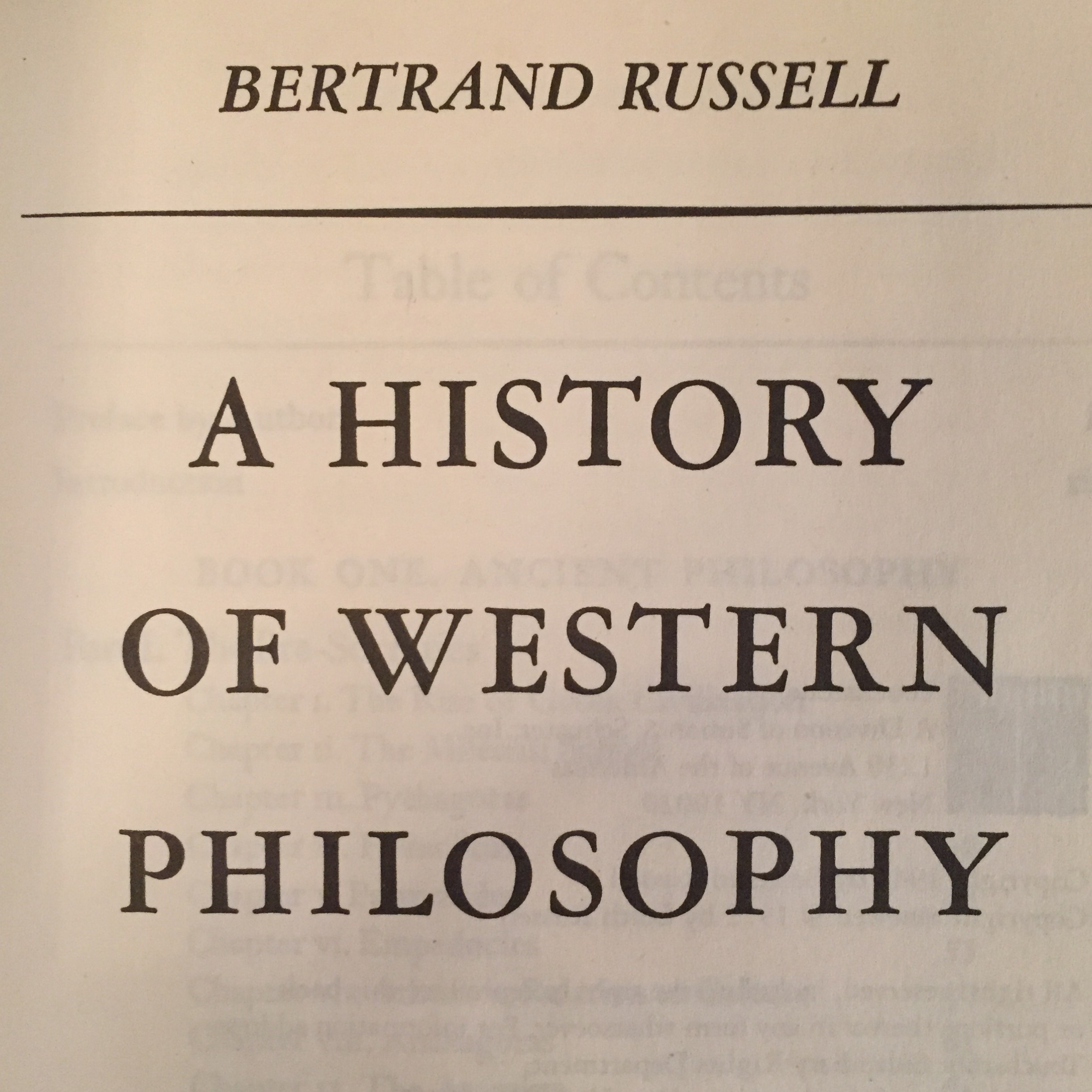
Bertrand Russell. A history of western philosophy. A Touchstone Book. Published by Symon & Schuster, 2007. [Reprint 1945].
ISBN-10: 1-4165-5477-7
ISBN-13: 978-4165-5477-6.
-
 Bando Mitsugorō III as Lady Iwafuji and Nakamura Matsue III as Lady Onoe, 1821.「局岩ふじ 坂東三津五郎」(三代)、「中老尾上 中村松江」(三代) in kabuki play Kagamiyama Kokyô no Nishikie [鏡山旧錦繪] (Mirror mountain: A women’s treasury of loyalty); author: Yô Yôdai. Artist: Shunkōsai Hokushū (春好斎 北洲), who is also known as Shunkō IV, active from about 1802 to 1832. Actors: Bandō Mitsugorō III [三代目 坂東 三津五郎] (Japanese, 1775 – 1831); other names: Bandō Minosuke I, Morita Kanjirô II, Bandō Mitahachi I, Bandō Minosuke I, Bandō Mitahachi I. Nakamura Matsue III [三代目中村松江] (Japanese, 1786-1855); other names: Nakamura Sankō I, Nakamura Tomijūrō II, Ichikawa Kumatarō. Year: 1821 (Bunsei 4), 1st month. Publisher: Wataya Kihei (Wataki) (Japanese, fl. c. 1809 – 1885) Signed Shunkôsai Hokushû ga 春好斎北洲画. MFA Accession № 11.35375. MFA description: "Play: Keisei Kagamiyama (Mirror Mountain, a Courtesan Play). Theatre: Kado けいせい双鏡山(けいせいかがみやま)角. Ref.: [LIB-1193.2013] Leiter. Kabuki Encyclopedia, p. 156; [LIB-0879-2.2015] Kabuki plays on stage (vol. 2): 1773-1799, pp. 172-212.
Bando Mitsugorō III as Lady Iwafuji and Nakamura Matsue III as Lady Onoe, 1821.「局岩ふじ 坂東三津五郎」(三代)、「中老尾上 中村松江」(三代) in kabuki play Kagamiyama Kokyô no Nishikie [鏡山旧錦繪] (Mirror mountain: A women’s treasury of loyalty); author: Yô Yôdai. Artist: Shunkōsai Hokushū (春好斎 北洲), who is also known as Shunkō IV, active from about 1802 to 1832. Actors: Bandō Mitsugorō III [三代目 坂東 三津五郎] (Japanese, 1775 – 1831); other names: Bandō Minosuke I, Morita Kanjirô II, Bandō Mitahachi I, Bandō Minosuke I, Bandō Mitahachi I. Nakamura Matsue III [三代目中村松江] (Japanese, 1786-1855); other names: Nakamura Sankō I, Nakamura Tomijūrō II, Ichikawa Kumatarō. Year: 1821 (Bunsei 4), 1st month. Publisher: Wataya Kihei (Wataki) (Japanese, fl. c. 1809 – 1885) Signed Shunkôsai Hokushû ga 春好斎北洲画. MFA Accession № 11.35375. MFA description: "Play: Keisei Kagamiyama (Mirror Mountain, a Courtesan Play). Theatre: Kado けいせい双鏡山(けいせいかがみやま)角. Ref.: [LIB-1193.2013] Leiter. Kabuki Encyclopedia, p. 156; [LIB-0879-2.2015] Kabuki plays on stage (vol. 2): 1773-1799, pp. 172-212. -
 Iron tsuba of round form with design of military commander's fan (gunbai) in openwork (sukashi). Square rim. Hitsu-ana plugged with lead or tin. Ko-tosho school. Mid Muromachi period. Late 15th century: Entoku era [1489-92] / Meio era [1489-1501]. Height: 80.3 mm, Width: 81.5 mm, Rim thickness: 3.0 mm. Centre thickness: 3.5 mm. Provenance: Sasano Masayuki Collection, №23 in Japanese Sword Guard Masterpieces from the Sasano Collection, 1994: Ko-tosho. Sukashi design: Military commander's fan (gunbai). Mid Muromachi period. Late 15th century (Entoku / Meio era). The military commander's fan (gunbai) was cherished by samurai warriors. This tsuba is relatively thick, with the large fan nicely positioned on the plate.
Iron tsuba of round form with design of military commander's fan (gunbai) in openwork (sukashi). Square rim. Hitsu-ana plugged with lead or tin. Ko-tosho school. Mid Muromachi period. Late 15th century: Entoku era [1489-92] / Meio era [1489-1501]. Height: 80.3 mm, Width: 81.5 mm, Rim thickness: 3.0 mm. Centre thickness: 3.5 mm. Provenance: Sasano Masayuki Collection, №23 in Japanese Sword Guard Masterpieces from the Sasano Collection, 1994: Ko-tosho. Sukashi design: Military commander's fan (gunbai). Mid Muromachi period. Late 15th century (Entoku / Meio era). The military commander's fan (gunbai) was cherished by samurai warriors. This tsuba is relatively thick, with the large fan nicely positioned on the plate. -
 Iron tsuba with design of a cricket and grass inlaid in brass (suemon-zōgan) and a bridge over a stream in openwork (sukashi) on both sides. Inlay of distant part of the cricket's antenna is missing. Heianjō School. Momoyama period. Diameter: 79.5 mm, thickness at seppa-dai: 3.3 mm NBTHK # 4002100.
Iron tsuba with design of a cricket and grass inlaid in brass (suemon-zōgan) and a bridge over a stream in openwork (sukashi) on both sides. Inlay of distant part of the cricket's antenna is missing. Heianjō School. Momoyama period. Diameter: 79.5 mm, thickness at seppa-dai: 3.3 mm NBTHK # 4002100. -
 An unsigned print, presumably by Katsukawa Shunshō that presumably depicts a kabuki actor Ichikawa Monnosuke II. I was not able to find any reference of the image. Size: Hosoban. According to The actor's image. Print makers of the Katsukawa School. Timothy T. Clark and Osamu Ueda with Donald Jenkins. Naomi Noble Richard, editor The Art Institute of Chicago in association with Princeton University Press, 1994, Ichikawa Monnosuke II was born in 1743, in Ōji Takinogawa, Edo. He died on October 19, 1974. His specialities were young male roles (wakashu) and male leads (tachi yaku). He was considered to be one of the four best young actors of his day.
An unsigned print, presumably by Katsukawa Shunshō that presumably depicts a kabuki actor Ichikawa Monnosuke II. I was not able to find any reference of the image. Size: Hosoban. According to The actor's image. Print makers of the Katsukawa School. Timothy T. Clark and Osamu Ueda with Donald Jenkins. Naomi Noble Richard, editor The Art Institute of Chicago in association with Princeton University Press, 1994, Ichikawa Monnosuke II was born in 1743, in Ōji Takinogawa, Edo. He died on October 19, 1974. His specialities were young male roles (wakashu) and male leads (tachi yaku). He was considered to be one of the four best young actors of his day. -
 Iron tsuba of round form with slanting rays of light (shakoh) Christian motif (Jesuit's IHS symbol) in openwork (sukashi). Traditional description of this kind of design is called "tokei", or "clock gear". Edo period.
Iron tsuba of round form with slanting rays of light (shakoh) Christian motif (Jesuit's IHS symbol) in openwork (sukashi). Traditional description of this kind of design is called "tokei", or "clock gear". Edo period.Size: 77.7 x 76.1 x 6.7 mm.
For information regarding shakoh tsuba see article 'Kirishitan Ikenie Tsuba" by Fred Geyer at Kokusai Tosogu Kai; The 2nd International Convention & Exhibition, October 18-23, 2006, pp. 84-91. -
 Woman Looking out a Round Window at a Woman with a Komusō Hat.
Woman Looking out a Round Window at a Woman with a Komusō Hat.Artist Koikawa Harumasa (a.k.a. Banki): fl. 1801–18. Wikipedia: Koikawa Harumasa (恋川 春政; active 1800–1820), later called Banki Harumasa (晩器 春政). Associated with Katsukawa school.
Signed: Banki ga (on the bamboo flower container in the background). Censor's seal: kiwame. Mark of unidentified publisher, Genshoku #1017; Marks U084 Ibiko, p. 387.
References:
Jacob Pins #828.


